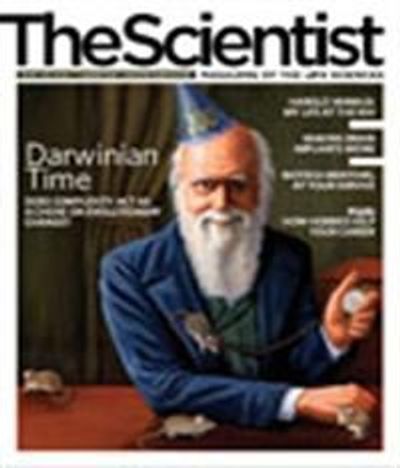
For more than a century, scientists used the fossil record to look back in evolutionary history and believed that the ancestors of modern mammals originated and flourished around 65 million years ago, at the extinction of nonavian dinosaurs known as the Cretaceous/Tertiary (K/T) boundary.
But about 30 years ago, researchers began to estimate when species diverged by comparing the number of differences in their DNA (called molecular clock dating) and made their own evolutionary phylogenies in addition to the phylogenies based on the fossil record. By the turn of the 21st century, however, scientists began noticing that dates on the various mammalian phylogenies weren't adding up: molecular data suggested that modern mammals originated during the Cretaceous period, more than 100 million years ago—a time period without fossils that resemble modern mammals.
In this month's Hot Paper a group of researchers from Europe and the United...
The debate
Only two months after the Hot Paper was published, John Wible, at the Carnegie Museum of Natural History, led a team of researchers that offered a counterpoint to the dates on the supertree as they worked to determine where their new fossil of a shrew-like mammal, called Maelestes gobiensis, fell in mammalian evolutionary history.
Although the supertree dated the origin of mammals at 93 million years ago and showed 43 placental lineages surviving the K/T boundary, Wible's analysis of more than 400 morphological characters in Cretaceous fossils across 69 taxa placed the oldest placentals at 63 million years ago. "There was no evidence in the fossil record that any of Cretaceous forms previously identified [by molecular biologists] as placentals were in fact placentals," says Wible.
Although fossils were used to date divergence points on the supertree, they could only date back to around 55-65 million years ago, where paleontologists have fossil evidence of modern mammals. "Until there's [fossil evidence of] a Cretaceous primate that everyone agrees upon there will be conflict between molecular and paleontological evidence," says Ross MacPhee, from the American Museum of Natural History.
The supertree pulled the existing phylogenies together "like pieces of a jigsaw puzzle, each one offering a more complete picture of mammalian evolution," Bininda-Emonds says. To create a more reliable complete mammalian phylogeny Bininda-Emonds admits researchers would need to compare the same gene sequence or phenotype across every mammalian species.
"[Ideally], you'd sequence the whole genome, for all 5,000 species" of present-day mammals, says Kate Jones, from the Zoological College in London and collaborator on the Hot Paper. But that could take decades, says Jonathan Davies, at the University of California, Santa Barbara. "The problem is, in some cases [as in predicting species extinction], we can't wait that long."
The applications
Last October, Charles Nunn of Harvard University, used the dates that primates, artiodactyls (hoofed mammals), and carnivores diverged on the supertree to first establish how closely related the mammalian groups are to each other. He then compared white blood cell counts between male and females in each species. He discovered that, across the three mammalian groups, the amount of time a female spends breeding over her lifetime correlates with an increase in the number of white blood cells compared to males.
Davies is using the mammalian tree to study how diseases move across species. Using the supertree to compare when and where primates diverged in evolutionary history and the spread of diseases, his group concluded last year that unlike the transmission of most pathogens, virus transmission is more dependent upon species coming into contact with one another than evolutionary relatedness, suggesting viruses can move across animals who last shared a common ancestor even hundreds of millions of years ago.
On the other hand, the supertree is helping to predict which species are most vulnerable to future extinction thanks to natural and man-made threats. Starting with the International Union for Conservation of Nature Red List of endangered mammals, mammalian traits and geographic databases, Davies and colleagues extrapolated information about species relationships from the supertree, and identified factors driving living mammals toward extinction: large body size, small geographic ranges, and slow reproduction rate.
"These are the age-old questions Darwin asked: Is speciation related to reproduction speed, the ability to out-compete other groups, eat and live in wide habitat ranges?" says John Gittleman, at the University of Georgia and co-author of the Hot Paper. "Darwin didn't have a phylogeny. The rate-limiting step [to these answers] is a comprehensive phylogeny."
References
1. O. Bininda-Emonds et al., "The delayed rise of present-day mammals," Nature, 446:507-12, 2007. (Cited in 73 papers). 2. J. Wible et al., "Cretaceous eutherians and Laurasian origin for placental mammals near the K/T boundary," Nature, 447:1003-6, 2007. 3.C.L. Nunn et al., "On sexual dimorphism in immune function," Philos Trans R Soc London, Epub Oct. 16, 2008 4. T. Davies et al., "Phylogeny and geography predict pathogen community similarity in wild primates and humans," Proc Biological Sci, 275:1695-701, 2008. 5. T. Davies et al, "Phylogenetic trees and the future of mammalian biodiversity," Proc Natl Acad Sci, 105:11556-63, 2008.Interested in reading more?
